140 Search Results for schedules
January 31, 2022
by Carole Zangari -
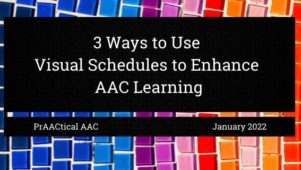
Visual schedules are a go-to strategy for helping AAC learners understand the plan for therapy or instructional session or a whole day. They have great utility beyond that, though. If you’re looking for ways to increase your use of this evidence-based strategy, here are some ideas to consider. Create a Visual Representation of an Activity: A powerful way to build understanding of and cooperation with an activity is to show what will be happening. This is particularly helpful when doing an activity that has a logical sequence or set of steps to be followed, such as making a smoothie or building a Lego car. We can create and teach the use of mini schedules depicting each element of the process to help our AAC clients/students become more comfortable and independent with the process. Parts of a Problem-solving Process: When AAC learners confront challenging situations, particularly those with a social or... [Read More...]
March 11, 2019
by Carole Zangari -
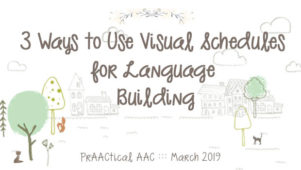
Visual schedules are powerful tools for supporting comprehension, reducing anxiety, and helping learners with AAC needs become more independent. They can also be used to build receptive and expressive language. To do that, though, the use of daily or mini/task schedules has to be part of an interactive experience, not an independent activity. If you’re willing to use schedules for language building, here are some ideas to consider incorporating. Sentence Building: This is an easy one. If you are working with an AAC learner who communicates primarily with one word/symbol at a time, slow down and take time to model short sentences every time you check the schedule together by adding a verb (e.g., GO to LifeSkills; EAT lunch, PUT AWAY your backpack). Once you’ve established that routine, you can pause to elicit those same sorts of sentences from the AAC learner. Verb Tense: As you use the schedule... [Read More...]
December 21, 2016
by Carole Zangari -
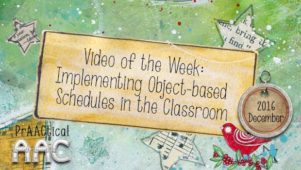
Working with learners who have difficulty transitioning from one activity to the next? Visual schedules are a well-known strategy for supporting transitions, but most of us use pictures to represent the various activities. In some cases, this may not be the best approach. Today’s video describes a case example of a young learner who needed the support of objects. Hear how his team addressed this need and get useful tips for implementation. Be sure to download the handout and supporting resources while you’re there. Many thanks to TASN for making this available. Direct Link to Video: https://www.ksdetasn.org/resources/590
September 16, 2015
by Carole Zangari -
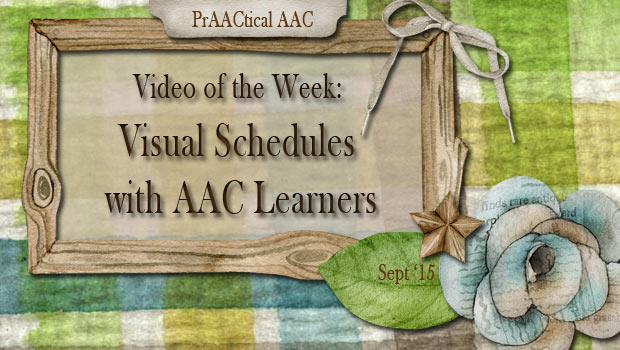
While our therapy sessions are highly individualized to meet the needs of specific individuals, there are a couple of strategies that are effective with almost every learner on our caseloads. Topping that list is the use of visual schedules. Whether it is a written agenda, a picture schedule for the session, a mini schedule for the parts of an activity, or an object schedule for the day’s events, this is one of the few strategies that has something to offer every learner. We’ve written before about this topic. In this post, you can find links to many of the topics we’ve addressed about making and using them. Today, we’ll look at a few videos on the use of this strategy. To get us started, here’s a video of Ann Syrstad sharing information about using this evidence-based intervention for individuals with ASD. Next, we head to Malaysia, where the Early Autism... [Read More...]
July 22, 2013
by Robin Parker -
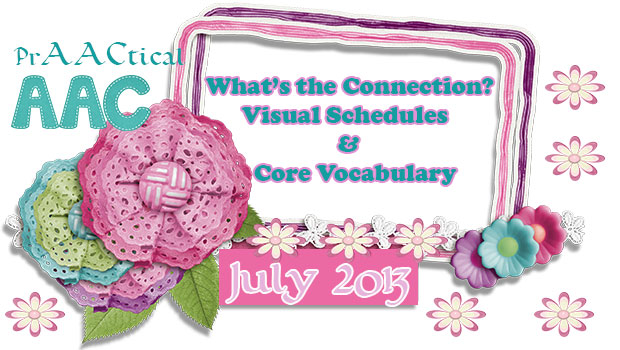
Because it seems there has been a lot of emphasis on core words and visual schedules over the past couple of months, we wanted to highlight a particular resource titled: Visual Schedules to Expose & Reinforce Core Vocabulary by (the great) Gail Van Tatenhove. This resource can be found on the Minspeak website which shares excellent (& free) comprehensive AAC information for everyone. You can search by categories and get fact sheets, communication boards, curriculum supports and more. AAC users, families, & caregivers Teachers and therapists Academicians & students Teaching Plans & Materials Pixon Project Resources Try out some of the ideas from the Visual Schedule/Core Word Resource or something else and let us know what you think.
June 8, 2012
by Robin Parker -
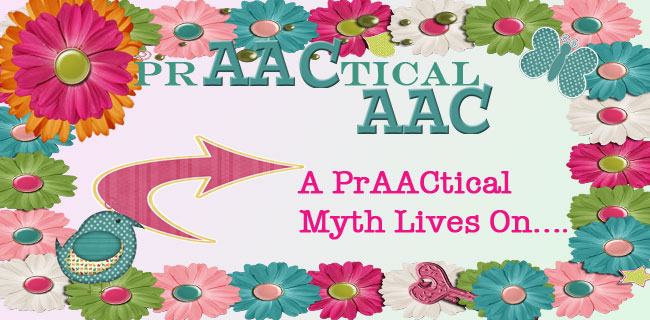
A myth about visual schedules continues to rear its ugly head in a prAACtical situation. Another family was instructed to discontinue a visual schedule because “the schedule will become a crutch, the schedule will result in dependence, and the schedule can not be used forever or all over town”. I need to start with an apology for not following up after my earlier post when I first realized that the visual schedule myth lived on. Maybe my punishment was hearing the same myth repeated (though it doesn’t seem fair that a student was impacted in the process). But maybe it was a teaching opportunity for me. It certainly made me respond quickly. So now for the down and dirty summary of my conversation with the other ‘professional’ . Having the conversation was my attempt at helping my student receive the visual language supports that she needed. I have to admit, it... [Read More...]
April 30, 2012
by Robin Parker -
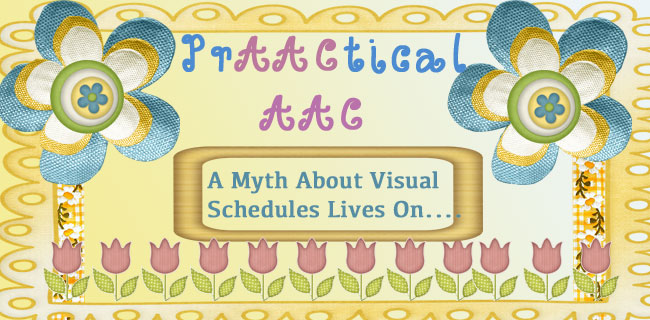
Nooooo, not again. A myth about visual schedules continues to rear its ugly head in a prAACtical situation (maybe we can reframe it into a learning opportunity??). Some history- A parent of twin girls with autism (age 15 and two other younger children– yes total 4) stopped by our office to pick up some autism awareness materials yesterday (a super busy mom in so many ways —going out of her way to help our community). As we were exchanging pleasantries and getting updates on how the girls were doing, we heard something that continues to surprise us–(and not in a good way). What did we hear? We heard that the girls were doing relatively well (not the surprising comment) but that mom was extra busy because the girls were no longer independent in taking their showers. They could do it by themselves but didn’t like the sensory input of soap... [Read More...]
April 11, 2012
by Carole Zangari -
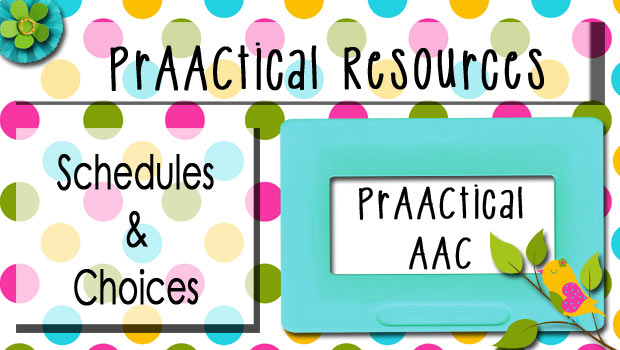
– If you follow our blog, you know that last month we had lots to say on making, teaching, and using Visual Schedules. We ran out of time before we could discuss a question that comes up a lot in our own clinical practice. What role does choice-making play in visual schedules? Here are some of the things we think about when we consider this for the schedules we make and use. We all like to have some say in what we do. Giving the learner an opportunity to make choices in a schedule makes sense when personal autonomy is a priority. Allowing the learner to choose which activities to place on the schedule supports personal autonomy: Having control over what happens in our lives is a big part of happiness for most people. – Here’s how we might do that with a visual schedule for a therapy session. 1.Select... [Read More...]
April 1, 2012
by Carole Zangari -
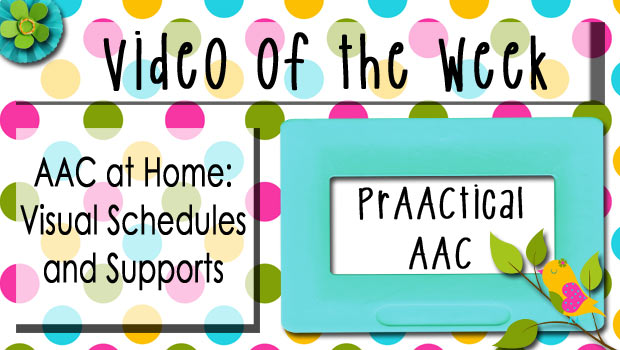
These videos from Autism House (in Indiana) have some great illustrations of using visual schedules and calendars at home. If you’re looking for different kinds of examples, these videos are for you. Click here for Part 1 and here for Part 2. —
March 25, 2012
by Carole Zangari -

This week, we feature a video that highlights software for making picture schedules by Cognitopia. We like how this video helps illustrate the decision-making process for developing a picture schedule using Picture Planner 3.0. You can download a free trial here and access the lite version of the app here. We like how this video reminds us to consider not just what the person will be doing at a particular time, but also what they will need to bring or have in order to be successful.









